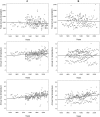Forest structure and roe deer abundance predict tick-borne encephalitis risk in Italy
- PMID: 19183811
- PMCID: PMC2629566
- DOI: 10.1371/journal.pone.0004336
Forest structure and roe deer abundance predict tick-borne encephalitis risk in Italy
Abstract
Background: The Western Tick-borne encephalitis (TBE) virus often causes devastating or lethal disease. In Europe, the number of human TBE cases has increased dramatically over the last decade, risk areas are expanding and new foci are being discovered every year. The early localisation of new TBE foci and the identification of the main risk factors associated with disease emergence represent a priority for the public health community. Although a number of socio-economic parameters have been suggested to explain TBE upsurges in eastern Europe, the principal driving factors in relatively stable western European countries have not been identified.
Methodology/principal findings: In this paper, we analyse the correlation between the upsurge of TBE in 17 alpine provinces in northern Italy from 1992 to 2006 with climatic variables, forest structure (as a proxy for small mammal reservoir host abundance), and abundance of the principal large vertebrate tick host (roe deer), using datasets available for the last 40 years. No significant differences between the pattern of changes in climatic variables in provinces where TBE has emerged compared to provinces were no clinical TBE cases have been observed to date. Instead, the best model for explaining the increase in TBE incidence in humans in this area include changes in forest structure, in particular the ratio of coppice to high stand forest, and the density of roe deer.
Conclusion/significance: Substantial changes in vegetation structure that improve habitat suitability for the main TBE reservoir hosts (small mammals), as well as an increase in roe deer abundance due to changes in land and wildlife management practices, are likely to be among the most crucial factors affecting the circulation potential of Western TBE virus and, consequently, the risk of TBE emergence in humans in western Europe. We believe our approach will be useful in predicting TBE risk on a wider scale.
Conflict of interest statement
Figures






References
-
- Alcamo J, Moreno JM, Novàky B, Bindi M, Corobov R, et al. Europe. Climate Change 2007: impacts, adaptation and vulnerability. In: Parry ML, Canziani OF, Palutikof JP, van der Linden PJ, Hanson CE, editors. Cambridge, UK: Cambridge University Press; 2007. pp. 541–580.
-
- Sumilo D, Bormane A, Asokliene L, Lucenko I, Vasilenko V, et al. Tick-borne encephalitis in the Baltic States: identifying risk factors in space and time. International Journal of Medical Microbiology. 2006;296:76–79. - PubMed
-
- Randolph SE. de la Roque S, Morand S, Hendrickx G, editors. Tick-borne diseases. Climate change: the impacts on the epidemiology and control of animal diseases. OIE Scientific and Technical Review. 27. 2007. In press.
-
- Randolph SE. Tick-borne encephalitis incidence in Central and Eastern Europe: consequences of political transition. Microbes and Infection. 2008;10:209–216. - PubMed
Publication types
MeSH terms
LinkOut - more resources
Full Text Sources

